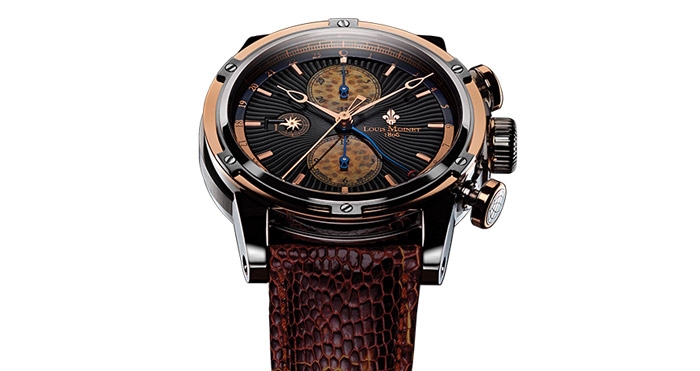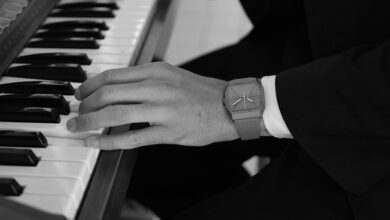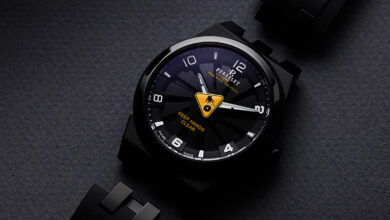Ateliers Louis Moinet’s intricate dials
As a child Louis Moinet developed a passion for watchmaking and spent all his free time with a master-watchmaker to harness his natural born gift of excelling in skilled crafts. In his twenties, he pursued the practical study of horology, the art for which he already nurtured a passion and became a master in his field
From that point onwards, watchmaking occupied his entire time and he spent long periods in Switzerland, from the Jura mountains to the Joux valley.As a maker of precision instruments, Louis Moinet was involved in maritime, astronomical and civilian horology, where he perfected various techniques in these fields and developed several key improvements.His major achievement was the ‘compteur de tierces’ of 1816, which makes him the inventor of what became known as the chronograph and it was not until exactly a century later that a watch was made to beat his record of 216,000 vibrations an hour. Upon his death, the watchmaker was forgotten to the steady cadence of time until a few years ago when his work was re-discovered by a savvy entrepreneur.
In the spirit of Louis Moinet, businessman Jean-Marie Schaller revived the prestigious name and established the Ateliers of Louis Moinet that are at Saint-Blaise near Neuchâtel in the heart of Switzerland’s watchmaking area. This independent company was established about 15 years ago and deliver exceptional timepieces that are a blend of art and technology with an aim to restore Louis Moinet to his rightful place at the top of the watchmaking pantheon. The 2015 collection is a remarkable array of masterpieces that may just have reached the upper echelons of the horology sector – below is a detailed outlook on the new collection, where all of Ateliers Louis Moinet’s timepieces are either exclusive limited editions or unique pieces.

AstroMoon
The AstroMoon is a complex mechanism that boasts a Moonphase indication, a 60 seconds tourbillon and a chronograph in a ground-breaking aesthetic approach. The astral theme of opening up the heavens is embodied into the aventurine dial of the watch, which also features a column-wheel chronograph, and genuine meteorite fragments, making this piece a limited edition of just 28. The watch is adorned by Ateliers Louis Moinet’s signature dew-drop hands that indicate time, a large tourbillon cage with curved bridges, a chronograph hand tipped by a star, and pushers that draw inspiration directly from the Compteur de Tierces, the first chronograph in history – invented by Louis Moinet in 1816.
Amidst all this, the Moonphase complication is the most enthralling. In similar fashion to the tourbillon positioned at 11 o’clock, it has been made as vast as possible in size, so that it can be admired against an aventurine backdrop. The feature has a unique design, as Jean-Marie Schaller, Ateliers Louis Moinet’s CEO, enthusiastically explains: “We started by taking a look at the most common Moonphases and noted one feature they all had in common: a tiny window that was not only small, but also only half-open – with the moon and night sky having to be squeezed into that half,” says Schaller. “Why not open up the heavens? After all, we don’t usually gaze up at a closed roof!” The result, positioned at 6 o’clock, is in the centre of a rotating disc, where two fragments of lunar meteorite face one another, symbolizing the moon. Around the disc is set a wide applique ring with curved indentations to show the moon’s phases as the disc turns.
Powered by a manual tourbillon movementthat is shielded by two sapphire crystals with non-reflective coating on both faces, the 373 part LM29 calibre hums at a steady beat of 21,600 vibrations per hour and boasts a power reserve of 46 hours. The 18 carat gold case measures 46.50mm in diameter and is water resistance to 50 metres.
“Derrick” Tourbillon
Limited to just 12 pieces, the Derrick Tourbillon is a world first, combining the mechanics of a 60 second tourbillon with a working oil derrick. Set against a petroleum blue dial decorated with “Côtes du Jura” ®, the unique device is in constant motion, completing its cycle every 15 seconds with its rocking lever crafted entirely of brushed aluminium. Two anti-glare sapphire crystals protect the working mechanism from accidental damage, giving full coverage both on the front and back of the watch. Restricted to the functions of hours and minutes, the Derrick Tourbillon is driven by a hand-wound movement that beats at a cadence of 21,600 vibrations per hour and offers a power reserve of 72 hours. The mesmerising timepiece is available in an exceptional 47mm 18K white gold case that is composed of 59 different parts and is water resistant to a depth of 30 metres.

Vertalor
Limited to just 28 pieces per model, the Ateliers Louis Moinet’s Vertalor is ushering in a new aesthetic era that features a tourbillon cage hung beneath a three-armed solid gold bridge, a first for the innovative brand. The architectural theme of suspension continues with the Vertalor’s barrel at 12 o’clock, of which the cover also hangs from a gold bridge that forms the backbone of the timepiece and heralds a completely new approach to open-dial watches.
Available in either an 18K pink or white gold polished case, the Vertalor embodies an interesting design that reveals the technical beauty of the dial, where two slightly curved open-work hands sweep across it. Eight curved, diamond-cut hour markers are interspaced on either side of the tourbillon and barrel that indicate passing time, whilst at 9 o’clock rests the Fleur-de-lis, the emblem of Ateliers Louis Moinet. This completely redesigned, enlarged, mirror-polished applique detail denotes both Louis Moinet’s place in the course of history and his native town of Bourges (which displays the Fleur-de-lis on its coat of arms). The Vertalor also boasts a fragment of meteorite in the centre of the dial and is water resistant to a depth of 30 metres. The mechanical movement is manual winding with a power reserve of 72 hours that is majestically displayed through a layer of sapphire crystal, allowing for great viewing of the hand-finished movement that oscillates at 21,600 vibrations per hour.
Derrick Gaz
Alive with creativity, the tourbillon-powered Derrick Gaz demonstrates a combination of aesthetic innovation and watchmaking prowess. The technicality of the timepiece is awe-inspiring but at the same time inspirational to witness, as the dial is based on an attentive observation of the traditional gas extraction systems of the nineteenth century, powered by an expansive tourbillon positioned at 6 o’clock.
The 18 carat gold gas derrick rises up majestically on the left-hand side of the timepiece, where in the middle there is a replica of a drill – an endless screw that is also in endless movement on the Derrick Gaz, rotating about its axis once every 2.5 seconds. From this point the gas resource begins its journey along the pipeline, symbolized by the tourbillon bridge, suitably curved in exactly the right tubular shape to maintain the distinctive aesthetic appearance of the timepiece. The same type of bridge is also to be found beneath the regulator system for the hours and minutes. Further along, the gas pipeline leads to the valve handle, which is directly linked to the crown to demonstrate the winding motion, this leads directly to a small circular disc that serves as the gas derrick’s manometer, which illustrates the power reserve of the hand-wound movement. The journey comes to a natural close at 3 o’clock, where the gas is stored in a tank made from fully polished 316L steel.
Driven by a 255 part Louis Moinet LM42 movement decorated with wave-pattern Geneva Stripes, the Derrick Gaz boasts a three-day power reserve and is available in two exclusive limited editions of 28 pieces each; in 5N 18 carat rose gold with a black dial, and PD150 18 carat white gold with a blue dial which features luminous dewdrop hands that signal time.
20 Second Tempograph
The Ateliers Louis Moinet 20 Second Tempograph offers a vibrant tribute to the genius of Louis Moinet that is technical, architectural and fun. The expansive watch dial showcases a twenty-second retrograde mechanism, developed in collaboration with Concepto. A second moving display at 9 o’clock demonstrates an openwork disc, in modest hues of white, grey and black that marks out the three twenty-second sequences in each minute. And finally, an hour dial positioned at four o’clock features blue-tinted hands with dewdrop tips that have become one of the aesthetic hallmarks of the renowned brand.
Powered by an in-house mechanical self-winding calibre LM39, which consists of over 260 parts, the watch generates a power reserve of 48 hours and beats at a steady pace of 28,800 vibrations per hour. The brand has taken great care to incorporate the detailed mechanical parts of the watch into the overall exterior look; for example, the designers were able to highlight the retrograde cam at 8 o’clock to give it a minimalist spiral shape. Similarly, the upper bridge is pearled, angled and polished entirely by hand; the plates have alternating sanded and polished finishes to give the dial a greater sense of depth. The back of the timepiece sports a movement adorned with a circular Côtes de Genève pattern, featuring diamond-cut chamfers and circular satin-finish gears with a 5N gold-toned finish. The 20 Second Tempograph is offered in a limited edition of 60 pieces in 44mm 18K pink or white gold and in a limited edition of 365 pieces in 43.5mm diameter Grade 5 titanium case that is water resistant to a depth of 50 metres.
GEOGRAPH rainforest
The GEOGRAPH rainforest is Ateliers Louis Moinet’s contribution to preserving the human heritage with the use of an exceptional new material: petrified palm wood. Each watch sold will enable a substantial contribution to the “PULAU BANDING Foundation”, which aims to preserve the Malaysian tropical forest of Belum-Temengor, one of the oldest in the world. Highlighted on the magnificent timepiece are two chronograph counters made from genuine petrified palm wood that are positioned at 12 o’clock and 6 o’clock, whilst the present time is indicated by “Gouttes de Rosée” dewdrop hands, on a dial adorned with “Côtes du Jura”®.
The dual-time display is read by a unique serpentine hand that forms a perfect match with the sinuous “Côtes du Jura” ® motif. In keeping with the idea that Ateliers Louis Moinet’s products must be beautiful from all aspects, the case-back is inspired by the tropical forest themes, where incredibly accurate engravings depict an orang-utan and a rhinoceros hornbill against the backdrop of the tropical forest and a starry sky. Energised by a self-winding mechanical movement with its 28,800 vibrations per hour, the watch boasts a 48 hour power reserve and is a unique creation issued in a 120 piece limited edition dedicated to the wrists of modern-day explorers.

Memoris
Driven by a 302 component LM54 calibre, with a rhythm of 28,800 vibrations per hour, the Memoris timepiece prominently displays the chronograph as a central component of the watch, instead of just a complication. This never-been-done-before design is a ground-breaking moment for the brand, who took a completely different approach to watchmaking rather than attempting merely to improve on an existing model.
The resulting timepiece features a 46mm diameter pink or white gold case that allows the chronograph to be presented atop a dedicated movement plate, separating it from the automatic movement beneath. Limited to just 60 pieces each, the watch boasts a 48 hour power reserve and an ingenious, automatic pawl winding system, called ‘Energie Plus’ . This system is completed with a miniature ceramic ball bearing that is mounted on the dual-material rotor. The advantage of ‘Energie Plus’ is that it allows the piece to be wound in both directions, with a minimum of excess travel.
Convex sapphire crystal serves to protect the dial from accidental damage, whilst the case back is fitted with 7 screws, engraved with individual number and Louis Moinet symbols, making the watch water resistant to a depth of 50 metres. The Memoris is completed with a hand-sewn Louisiana alligator leather strap with alligator lining.





